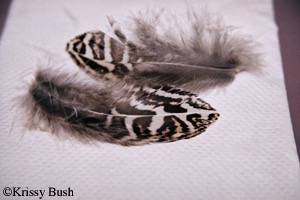EGGSHELLS (HATCHED OR PREDATED EGGS) - ZIP LOCK PROTOCOL
(1) Use a permanent marker to label a large zip lock bag with the following information:
• Female or nest's identification number
• Number of eggs in nest (hatched, predated, & unhatched) - if the eggs are crushed, put "?"
• Nesting attempt (1st or 2nd)
• Date
(2) Place all eggshell and membranes into the bag along with desiccant bags and seal it
(3) If the eggshells are wet, remove the eggshells from the bag and dry them on paper towel until they are dry (moisture degrades DNA)
(4) For hatched eggshells, separate each individual eggshell bottom into a small zip lock bag and label the bag with the EGG CODE "ESM + ID # - A, B, C, D, etc (last 2 digits of the year)" in sequential order. E.g. If you have 8 eggs from female 120 in 2006, the eggs will be labeled ESM120A(06) - ESM120H(06). If the tops are clearly attached to the bottoms, put them in the same bag as the bottom. If the tops are separate (most common situation), leave the tops loose in the large bag that contains all of the smaller bags since the tops could belong to any of the eggs. For predated eggs, separate each individual egg or large piece of egg into a small zip lock bag and label in the same manner as above. Leave all of the small crushed pieces loose in the large bag that contains all of the smaller bags since they could belong to any of the eggs. Put a small desiccant bag in each small zip lock bag to keep the samples dry (if they are moist and sealed in a zip lock bag without desiccant, the moisture will degrade the DNA).
(5) Store at room temperature
EGGSHELLS (HATCHED OR PREDATED EGGS) - ENVELOPE PROTOCOL (small coin envelope)
(1) For hatched eggs, put each egg bottom and top (unless they are attached to each other and obviously from one egg - then put in envelope together) into a labeled coin envelope (see below), squish the envelope so that the egg is crushed, and then seal the envelope. For predated eggs, remove all crushed eggshell/membrane that is attached to the predation opening on the egg (or that is along the edge(s) of a chunk of egg) and place in a small envelope. If the entire inside of the egg is covered with blood, put the entire egg in the envelope and crush the egg. If the rest of the egg contains no membrane, throw out the shell. If it does contain membrane, pick the membrane from the shell and place in the envelope for that egg. Information that should be on each envelope is as follows:
• Female or nest's identification number
• Egg code (see above)
• Number of eggs in nest (hatched, predated, & unhatched) - if the eggs are crushed, put "?"
• Nesting attempt (1st or 2nd)
• Date
(2) Place the envelopes in a box in sequential order so that they are easy to find.
(3) Store at room temperature
